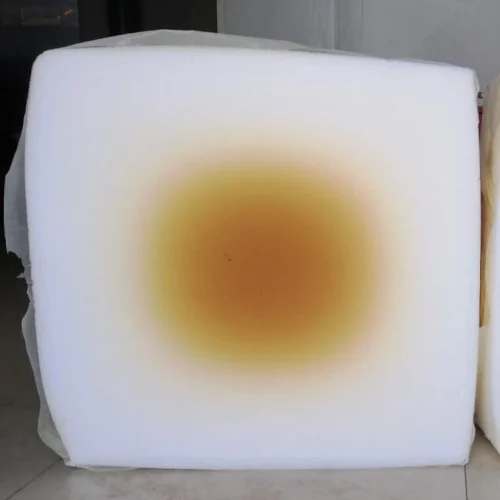Sponge core burning occurs when the internal temperature of the sponge is excessively high. The sponge’s temperature is influenced by the following factors:
1.Gas Volume: This includes the total volume of carbon dioxide generated from the reaction with water and the vaporized methane.
2.Heat Value Inside the Foam: Once the amounts of water and MC are determined, the heat value inside the foam generally falls within a certain range.
3.Reaction Speed: All three factors are variables rather than constants.
Analysis Based on Gas Volume and Heat Value Inside the Foam
When the heat value inside the foam remains constant, a larger gas volume results in a lower temperature. For instance, with 1,000 joules of heat confined in one unit of space, the temperature might be 50°C. If the heat spreads across two units of space, the temperature drops to 25°C. This demonstrates that during the steady foaming process of the sponge, heat undergoes a dilution effect.
Analysis Based on Heat Value and Reaction Speed
When the heat value is constant, the reaction speed significantly affects the process. A faster reaction speed generates more heat.
Strategies for Addressing Sponge Core Burning
To resolve sponge core burning, adjustments need to be made based on these three factors:
1. Adjusting the Heat Generation from the Reaction Between Water and TDI
The primary source of heat in sponge foaming is the reaction between water and TDI. Adjustments to this reaction are key.
For example, consider the following formula for a standard sponge:
·Polyol 560S (molecular weight: 3,000, hydroxyl value: 56)
·TDI: 80
If this formula results in slight core burning, a common approach is to reduce the amount of amine catalyst. Amine accelerates the reaction between water and TDI. By slowing the reaction, the heat generated decreases, leading to reduced thermal intensity without significant changes to other parameters.
2. Reducing Water and Increasing Methane
Reducing the amount of water while increasing methane helps maintain density with minimal changes to gas volume. Slight adjustments to amine levels further fine-tune the process. This reduces the foam’s heat value, which in turn lowers the overall internal temperature of the foam.
Additional Considerations
·Adding Water: While increasing water volume raises gas volume, it also significantly increases the heat value inside the foam. The rise in heat value is disproportionate to the increase in gas volume, resulting in higher internal temperatures and an increased likelihood of core burning.
·Adding Methane: Adding methane increases gas volume and decreases the heat value inside the foam. This combination leads to a lower internal temperature.
For instance, consider the case where water is increased to 4.3 and methane to 13. Whether the temperature rises or falls depends on specific calculations. While directional trends can be inferred in simpler cases, complex scenarios require precise computation. Key parameters needed include:
·Heat released from the two-step reaction between water and TDI.
·Heat from the reaction of polyether with TDI.
·Vaporization heat of methane.
Conclusion
The most commonly used adjustment method involves reducing water and increasing methane, with amine catalyst adjustments made as needed. This approach effectively manages the sponge’s internal temperature and mitigates core burning issues.

